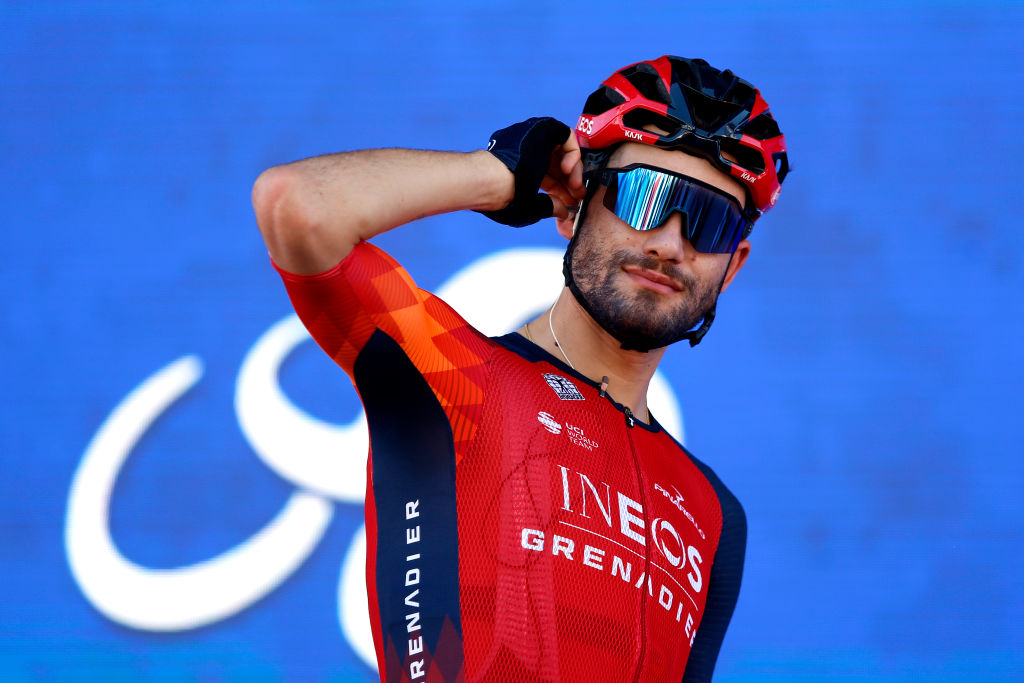Filippo Ganna takes centre stage for Italy and Ineos at Milan-San Remo
'I have to make it off the descent of the Poggio in a good position'

The retirement of Vincenzo Nibali already meant that Filippo Ganna was carrying home hopes at Milan-San Remo, while the absence of Tom Pidcock now means that the Italian is the figurehead for Ineos Grenadiers to boot.
Pidcock was ruled out of Milan-San Remo on Wednesday after it was confirmed that he had suffered a mild concussion in his crash on the final stage of Tirreno-Adriatico. It is not yet clear when the Strade Bianche winner will return to competition.
Ganna, meanwhile, won the opening time trial at Tirreno-Adriatico and held the blue jersey for three days before losing it to Primož Roglič on the uphill finale in Tortoreto. From there, Ganna looked to hone his form on the tough stages to Sassotetto and Osimo.
"It seemed harder and longer than usual and I suffered a lot on the stage [6] with the muri in the Marche," Ganna told La Gazzetta dello Sport. "But in general, in terms of my sensations, it went much better than in previous years.
"The build-up I had with my trainer Dario Cioni was good, with three blocks of work at home. It bore fruit."
Ganna has raced Milan-San Remo five times, never finishing higher than 51st, though he was prominent in the 2021 edition, working on the Poggio on behalf of Pidcock and 2017 winner Michał Kwiatkowski.
His deployment as a gregario on that occasion drew a degree of indignation in Italy, with one BiciSport headline trilling: "Wake up Ganna, you could have won Milan-San Remo."
Get The Leadout Newsletter
The latest race content, interviews, features, reviews and expert buying guides, direct to your inbox!
Ganna quickly diffused the polemic by explaining he had been ill in the build-up to the race. "Let's not all play at being a DS with all the ifs and buts," he said then.
Illness limited Ganna again last March, but he arrives at this year's race buoyed by a fine start to the season. His condition was evident in January when he placed second overall at the Vuelta a San Juan, a result he replicated at the Volta ao Algarve the following month. In between, he led Italy to the European team pursuit title.
If Ganna is win on the Via Roma on Saturday, he will need to produce a late charge of the kind produced by Fabian Cancellara in 2008 or by Jasper Stuyven two years ago.
"First, I have to make it to the bottom of the descent off the Poggio in a good position, and then I need to figure out whether to attack immediately or a bit further on. But going on the move before then would be difficult," said Ganna, who will look to avoid the usual pitfalls on the run-in.
"If you're behind on the Cipressa, you're in trouble. You have to make double to effort to move up and you mightn't manage it. This year, I have to understand how to take on the Poggio and its descent. Up until now, I've never managed to stay up front with the best."
Tadej Pogačar splintered the front group with a stinging series of accelerations on the Poggio 12 months ago and, after his exhibition at Paris-Nice, it seems inevitable that the Slovenian's moves will again dictate much of how the finale unfolds.
"There are riders who are fuoriclasse like him, and there are riders like me who have to work more, but I'm calm," Ganna said. "We all have two arms and two legs, no? Different weights, yes, but we have to see how the climbs are tackled and how we get to the climbs. Positioning is fundamental."

Barry Ryan was Head of Features at Cyclingnews. He has covered professional cycling since 2010, reporting from the Tour de France, Giro d’Italia and events from Argentina to Japan. His writing has appeared in The Independent, Procycling and Cycling Plus. He is the author of The Ascent: Sean Kelly, Stephen Roche and the Rise of Irish Cycling’s Golden Generation, published by Gill Books.